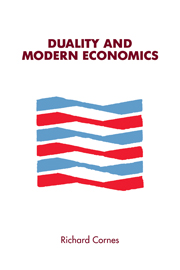Book contents
- Frontmatter
- Contents
- Preface
- PART I SOME BACKGROUND
- PART II MODELING INDIVIDUAL CONSUMER AND PRODUCER BEHAVIOR
- Chapter 2 Individual consumer behavior: Direct and indirect utility functions
- Chapter 3 Individual consumer behavior: Expenditure and distance functions
- Chapter 4 Individual consumer behavior: Further useful relationships and formulations
- Chapter 5 Producer behavior
- Chapter 6 Consumer and producer behavior: More useful topics
- Chapter 7 Consumer theory with many constraints
- PART III APPLYING THE MODEL OF INDIVIDUAL BEHAVIOR
- Epilogue
- Bibliography
- Author index
- Subject index
Chapter 7 - Consumer theory with many constraints
Published online by Cambridge University Press: 11 September 2009
- Frontmatter
- Contents
- Preface
- PART I SOME BACKGROUND
- PART II MODELING INDIVIDUAL CONSUMER AND PRODUCER BEHAVIOR
- Chapter 2 Individual consumer behavior: Direct and indirect utility functions
- Chapter 3 Individual consumer behavior: Expenditure and distance functions
- Chapter 4 Individual consumer behavior: Further useful relationships and formulations
- Chapter 5 Producer behavior
- Chapter 6 Consumer and producer behavior: More useful topics
- Chapter 7 Consumer theory with many constraints
- PART III APPLYING THE MODEL OF INDIVIDUAL BEHAVIOR
- Epilogue
- Bibliography
- Author index
- Subject index
Summary
Much of the power of the simple model of individual consumer behavior can be traced to the simple environment within which choices are made. It is summarized by a single linear constraint that is readily described by reference to the set of prices and the money income that the individual takes as given. One can interpret the model as one in which there are additional relevant constraints or variables, such as the state of the weather, that are assumed constant for the problem at hand and may therefore be suppressed as explicit variables.
There are, however, many interesting and important problems that involve multiple constraints in such a way as to require their explicit modeling. The wartime rationing experience in many countries during the 1940s, when consumers required ration coupons in addition to money, and even then often found that desired goods were unavailable, stimulated a brief flurry of interest among economists. The consequent literature was comprehensively surveyed by Tobin (1952), but then rather petered out as economists turned their attention to other matters. The waning of interest undoubtedly was attributable in part to the gradual phasing out of formal rationing devices. But in addition to feeling that models of quantity-constrained behavior were less relevant to economic conditions of the 1950s and 1960s, economists also must have felt discouraged by the difficulties encountered in applying the traditional formulation of consumer behavior to situations involving multiple constraints.
- Type
- Chapter
- Information
- Duality and Modern Economics , pp. 167 - 186Publisher: Cambridge University PressPrint publication year: 1992



